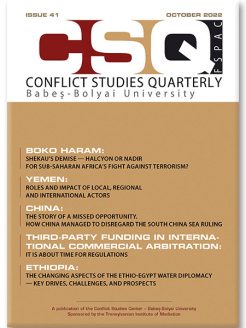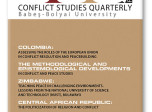
Issue 41 – October 2022
TOPICS: Boko Haram, Yemen, South China Sea, Arbitration, water diplomacy
Coordinator:
Christian Chereji and Ciprian Sandu
ARTICLES in Issue 41 – October 2022:
Boko Haram: Shekau’s Demise – Halcyon or Nadir for Sub-Saharan Africa’s Fight Against Terrorism?
Babatope Matthew AJIBOYE
Abstract:
in Sub-Saharan Africa, no terrorist group has been as lethal as Boko Haram, under the leadership of Abubakar Shekau. Barely more than a decade, since the group’s inception, the entire Sub-Saharan Africa has been engulfed by deadly activities of the dreaded terrorist group. From evidence, more than 40,000 people have been killed, over 2 million people have been displaced, scores of forced migrants have been scattered across West Africa, properties worth billions of dollars have been destroyed, and governance in the sub-region has, essentially, been ineffective since 2009, when the group launched its violent campaign. Although there were responses both at the local front and regional front to hold back the menace of Boko Haram, these efforts were repeatedly met with repression under Shekau. However, on June 7th, 2021, there was a turn of events, as Abu Musab Al Banawi, leader of the Islamic State of West Africa Province (ISWAP), confirmed the death of Shekau arising from a confrontation with this rival group. The question posed by this atypical occurrence is, ‘can we convincingly say Shekau’s death means the end of the road for terrorism in Sub-Saharan Africa?’ This article argues the opposite. Rejigging the memory of Mohammed Yusuf’s extermination by the police, Shekau’s influence, and the dominance of the Islamic State of West Africa Province (ISWAP), as the radical points of departure, the paper sees Shekau’s death as an alleyway for dynamic terrorism in Sub Saharan Africa.
Keywords:
Shekau, Halcyon, Nadir, lethal, terrorism, Sub-Saharan, Africa.
DOI: https://doi.org/10.24193/csq.41.1
Yemen: Roles and Impact of Local, Regional and International Actors
Adeb Abdulelah Abdulwahid AL-TAMIMI & Uddagatti VENKATESHA
Abstract:
The Yemeni conflict is complicated due to the numerous internal crises and disputes in the country. In addition, the external correlations and their linkages to the internal actors have increased the intensity of the conflict. There is a need to identify these internal and external actors and analyze their role, impact, strengths, and weaknesses. This study identifies the internal and external actors of the conflict in Yemen, then examines their roles and impact and shows that the conflict resulted from internal conflicts between local actors and took on different dimensions through regional and international interventions. The political, ideological, and self-interest differences are the causes of the disunity among the elites and the political and military forces, and in turn, they led to the exacerbation of the conflict and the negative role in peacemaking.
Keywords:
Houthi, legitimacy, Southern Movement, Tribal, Yemen Conflict.
DOI: https://doi.org/10.24193/csq.41.2
China: The Story of a Missed Opportunity. How China Managed to Disregard the South China Sea Ruling
Tudor CHERHAT
Abstract:
On July 12, 2016, an international tribunal (registered with The Hague Permanent Court of Arbitration) ruled against China`s territorial claims in the South China Sea, arguing that the Chinese historic rights within the Nine Dash-Line map have no valid effect under the United Nations Convention on the Law of the Sea (UNCLOS). The tribunal’s decision came at a time when tensions in the South China Sea had reached a very high level amid increasing maritime incidents caused by China and the Chinese government’s construction of artificial islands in the open sea. What was supposed to be a major victory against China for the US-backed states (Vietnam, Philippines), turned out to be only a symbolic success for the Philippines. China not only rejected the sentence, but continued to conduct provocative naval exercises, harass other foreign ships and build artificial islands for military purposes. Using historical research and comparative analysis, this paper illustrates how China’s rejection of the ruling was facilitated by a number of legal, economic and political factors that have diminished international reactions and pressures on the Chinese government: the non-ratification of UNCLOS by the US, the lack of coercive mechanisms to enforce international rulings, the economic interdependence between China and other regional states and the precedents set by other major powers.
Keywords:
South China Sea, Permanent Court of Arbitration, UNCLOS, maritime claims, historic
rights.
DOI: https://doi.org/10.24193/csq.41.3
Third-Party Founding in International Commercial Arbitration: It Is About Time for Regulations
Shantanu PACHAHARA & Vikas GHANDI
Abstract:
Third-party funding (TPF) is a species of the common law doctrine of maintenance and champerty. With the burgeoning of global trade, the need for funding arbitral proceeding of high magnitude have witnessed an upward trend. TPF is a method wherein the impecunious party to the dispute enters into a contract with a third-party, who is not a party to the arbitration agreement, to finance the arbitration proceeding and run the risk of either paying or receiving the proceeds, costs, or award awarded against or in favor of such party. TPF, on one hand, provides a gateway to justice to the impecunious party and on the other hand, causes an impediment to the recognition and enforcement mechanism of arbitral awards. TPF flourishes as an alternative to support arbitral proceedings by acting as an investment for the financers but what impact it has on the market, in the long run, is still unclear. TPF assists the struggling party to appoint highly qualified specialists and a learned arbitrator through financial assistance but restricts the party autonomy and raises justifiable doubts as to the independence and impartiality of the arbitrator due to the leverage the financer holds in such an arrangement. Last but not least, TPF may also, at times, result in the disclosure of attorney-client communication to the financer. The present article is an analytical study of TPF as a mechanism in international commercial arbitration and what challenges it poses to its practice. Moreover, the article places reliance on the work of various scholars, and adopting the inductive approach of reasoning, reflects upon the plausible remedies for challenges that TPF poses to international commercial arbitration.
Keywords:
Third-party funding, commercial arbitration, international; challenges; regulation.
DOI: https://doi.org/10.24193/csq.41.4
Ethiopia: The Changing Aspects of the Ethio-Egipt Water Diplomacy – Key Drives, Challenges and Prospects
Nigusu Adem YIMER
Abstract:
Starting the inception of the 2010s, Ethiopia’s relations with Egypt have been experiencing one of the deepest crises in the relationship of the two countries’ history. Ethiopia, one of the upper riparian states of the Nile River not only theoretically challenged the exclusive veto power of Egypt over the Nile River but also practically start constructing one of Africa’s largest hydropower dams on the Blue Nile since 2011. The challenging behavior of Ethiopia over the Nile River worried the long-standing regional hegemon, Egypt. Against this background, this paper aims to forward a new insight into how and why Ethiopia challenged the long-standing superior-subordinate Egypt-led order over the Nile River. Moreover, in its discussion, the paper tries to address key drives, challenges, and prospects of Ethiopia-Egypt water diplomacy. The paper also illustrates how and why the Ethio Egypt water diplomacy strain becomes a cross-cut on the two nation’s foreign policy matters. The paper has also attempted to understand how the superior-subordinate power duality approach works over the Nile River against the new balancer.
Keywords:
Ethiopia, Egypt, relation, Nile River, challenges, prospects.



